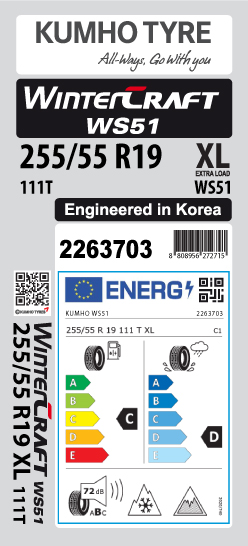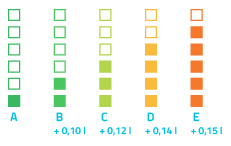The new tyre label: for increased
transparency and safety
On 1 May 2021, the new EU regulation 2020/740 on the labelling requirements for motor vehicle tyres comes into effect. The tyre label is mandatory for all new tyres produced as of 1 May 2021. The new label will make it easier to identify and compare three important performance characteristics: fuel efficiency, braking performance in wet conditions and noise levels.


Fuel efficiency
Rolling resistance and associated fuel efficiency.
What was formerly E is now D. What was formerly F and G are the new E.

Wet grip
Braking performance on wet road surfaces. A is the best score.
What was formerly E is now D. What was formerly F and G are the new E.

Rolling noise
New representation: now with A-B-C classification (A = low noise level) instead of sound waves. Additional specification of the decibel value.

QR-Code
Link for downloading specific tyre data from the European Product Database for Energy Labelling (EPREL)

New pictograms
The symbols indicate the suitability of the tyre for snow (3PMSF) and ice (only C1 tyres for cars incl. SUVs).

Fuel savings depend fundamentally on the vehicle, driving style and driving conditions. If a vehicle is fitted all round with Class A tyres as opposed to Class E, fuel consumption can potentially be reduced by up to 7.5%. This value can be even higher with commercial vehicles.

The degree of effectiveness depends fundamentally on the vehicle and driving conditions. With full brake application, the braking distance can be shortened by up to 30% on a vehicle fitted all round with Class A as opposed to Class E tyres. On a “normal” car travelling at a speed of 80 km/h, the braking distance on a road surface with average grip can be up to 18 m shorter.
External rolling noise
The external rolling noise of the tyre is indicated in decibels as well as a classification from A to C. It should be noted here that the external rolling noise of the tyre does not always correlate with the noise in the vehicle interior.
The pictogram with three black stripes means that the external rolling noise of the tyre complies with the EU upper limits that have applied since 2016.
Two black stripes indicates that the external rolling noise of the tyre complies with the EU upper limits that have applied since 2016 or are up to 3 dB below the limit.
One black stripe indicates that the external rolling noise of the tyre is more than 3 dB below the EU upper limits that have applied since 2016.


